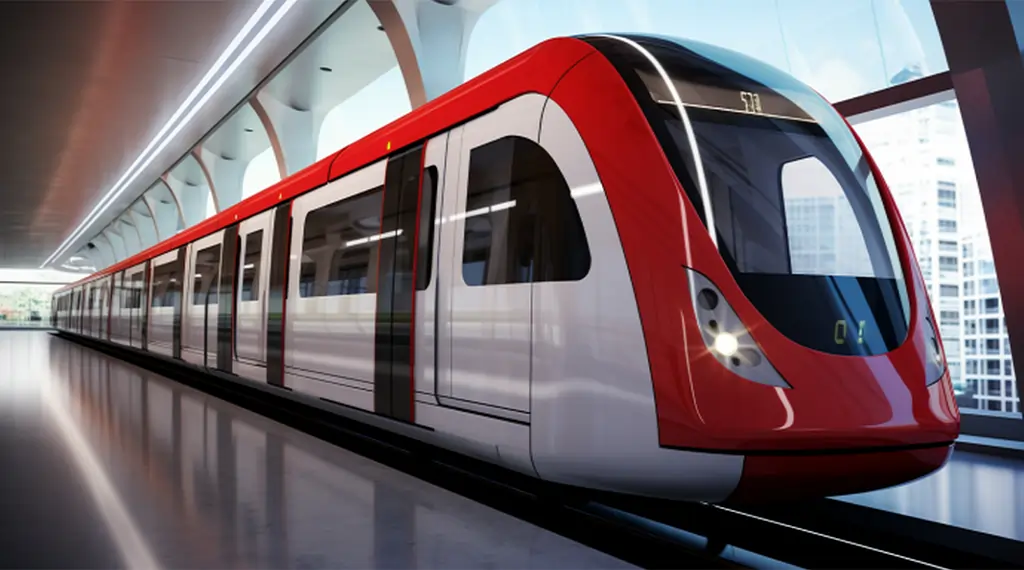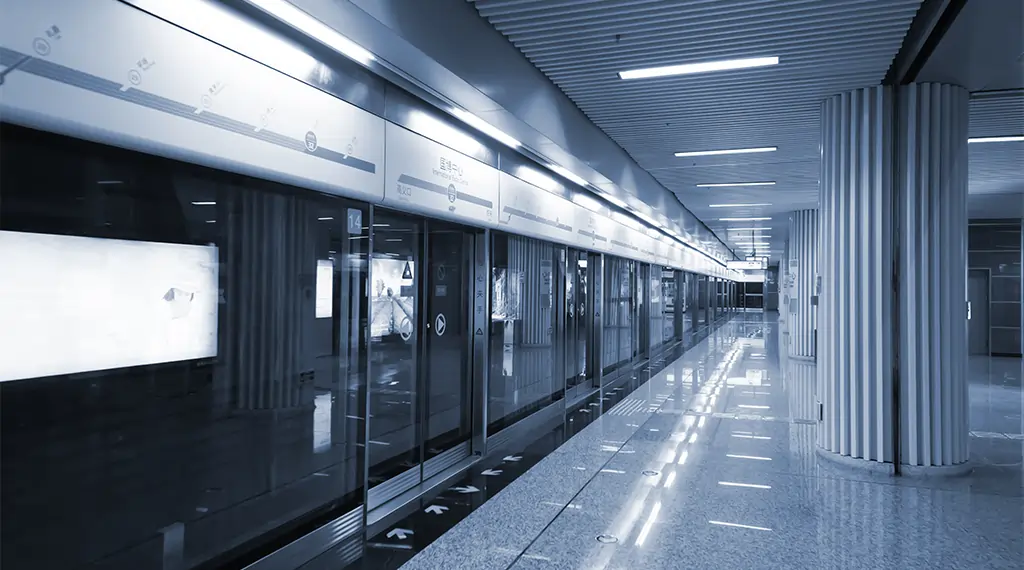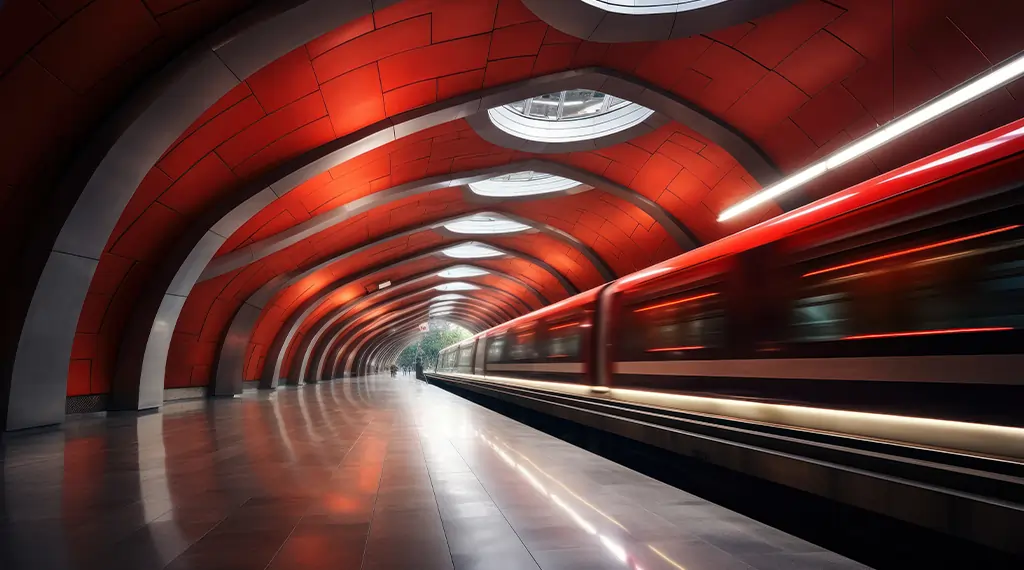
Shaheed Sthal Metro Station, also known as New Bus Adda Metro Station, is a crucial transportation hub connecting Ghaziabad with Delhi. As the terminal point of the Delhi Metro Red Line, it significantly impacts daily commuting and the socio-economic dynamics of the National Capital Region. Since its inauguration, Shaheed Sthal has evolved into more than just a transit point; it has reshaped how people travel, live, and conduct business in Ghaziabad and its surrounding areas.
Strategically positioned, Shaheed Sthal Metro Station offers easy access to various parts of Ghaziabad and beyond. Its proximity to the NH 58 bus station, a major hub for buses traveling between Meerut and New Delhi, allows passengers to seamlessly switch between metro and bus services. The station’s location also provides connectivity to important landmarks, enhancing its importance for daily commuters and visitors.
The station’s name, “Shaheed Sthal,” honors a martyr of the Kargil War, adding a layer of historical significance to the site. This tribute reflects the nation’s respect for its heroes, embedding a sense of pride and remembrance into the daily commute.
Shaheed Sthal Metro Station is designed to provide a comfortable and efficient commuting experience. With multiple entry and exit points, ticket counters, customer care services, and security measures, the station caters to the needs of thousands of daily passengers. Accessibility features such as elevators, ramps, and tactile paths ensure that all commuters, including those with disabilities, can navigate the station with ease.
The introduction of Shaheed Sthal Metro Station has spurred real estate development in nearby areas, increasing demand for residential and commercial properties. This connectivity has transformed local neighborhoods into bustling hubs, attracting businesses and residents alike. As a vital component of the Delhi Metro network, Shaheed Sthal Metro Station continues to drive urban growth and improve the quality of life for people in Ghaziabad and the broader NCR region.
Historical Background
The historical background of Shaheed Sthal Metro Station is closely intertwined with the evolution and expansion of the Delhi Metro’s Red Line. Originally conceived as part of the Delhi Metro’s Phase III expansion, the station was constructed to extend metro connectivity deeper into Ghaziabad, a rapidly growing urban center in the National Capital Region. The Red Line itself holds the distinction of being the first operational corridor of the Delhi Metro, with its earliest section inaugurated in 2002. However, the extension from Dilshad Garden to Shaheed Sthal was a significant milestone, officially opening to the public on March 8, 2019, and adding 9.63 kilometers to the network.
The station, initially known as New Bus Adda, was renamed in 2019 to honor the memory of a martyr from the Kargil War, reflecting the community’s respect for national heroes and infusing the station with a sense of local pride and historical significance1. This renaming also marked a symbolic connection between the station and the values of sacrifice and patriotism, making it more than just a transit point for daily commuters.
Since its inauguration, Shaheed Sthal Metro Station has played a pivotal role in transforming urban mobility for Ghaziabad’s residents. It serves as a crucial transit hub, linking the city directly to northwest Delhi and providing seamless access to major interchange stations like Kashmere Gate and Inderlok. The station’s development has also spurred real estate growth in surrounding areas and improved access to key landmarks such as the NH 58 bus station and Red Mall Cinepolis. Over the years, Shaheed Sthal has evolved into a landmark that not only facilitates efficient transportation but also stands as a testament to the city’s progress and its enduring connection to the broader Delhi Metro network.
Location and Connectivity
Shaheed Sthal Metro Station, also known as New Bus Adda Metro Station, is the terminal point on the Delhi Metro’s Red Line, situated in Ghaziabad, Uttar Pradesh. The station is near the NH 58 bus station, a major transit point for passengers traveling between Meerut and New Delhi, and close to Red Mall Cinepolis. It is located on the link road connecting NH58 to NH24, enhancing its accessibility.
As part of the Delhi Metro’s Red Line, Shaheed Sthal connects Ghaziabad to Rithala in northwest Delhi. The station has two platforms that facilitate travel towards Rithala and towards Shaheed Stha. Entry and exit are managed through two gates. Gate 1 opens towards Meerut Mod, Pelican Hotel, and Dewan Diagnostics, while Gate 2 provides access to Red Mall and GT Road towards Mohan Nagar.
Shaheed Sthal Metro Station is connected to the Ghaziabad Railway Station. Key nearby locations include MMG Hospital (approximately 2.5 km away), Sihani Gate Police Station (about 3.9 km), Fire Station Ghantaghar, and Ghantaghar (both around 2.8 km from the station)
Metro Gates and Facilities
Shaheed Sthal Metro Station, also known as New Bus Adda Metro Station, a crucial transit hub on Delhi Metro’s Red Line, offers several facilities for passengers. The station has two platforms that facilitate travel towards Rithala and Shaheed Sthal1.
The station has two entry/exit gates. Gate 1 opens towards Meerut Mod, Pelican Hotel, and Dewan Diagnostics, while Gate 2 provides access to Red Mall and GT Road towards Mohan Nagar.
Key facilities available at the station include:
- Ticket counters and metro card vending machines.
- Customer care and information desks.
- Security checkpoints with baggage scanners and metal detectors.
- Waiting areas with seating arrangements.
- Clean washrooms and drinking water facilities.
- Elevators and escalators for easy movement between levels.
- Ramps and tactile paths for visually impaired passengers.
- Dedicated seating for senior citizens and differently-abled individuals.
- CCTV surveillance and trained security personne.
Though the station doesn’t have parking or feeder bus services, it is near the NH 58 bus station and Ghaziabad Railway Station, offering connections to other transport options
Public Transport Availability
Shaheed Sthal Metro Station is well-integrated with various public transportation options, making it a crucial transit point for commuters in Ghaziabad and those traveling to and from Delhi. The station’s location near the NH 58 bus station is a significant advantage, as this bus station serves numerous intercity buses, particularly those running between Meerut and New Delhi. This allows for easy transfers between the metro and bus services, enhancing connectivity for passengers traveling longer distances.
In addition to buses, commuters can readily find auto-rickshaws, cycle-rickshaws, and local taxis outside the station, providing convenient last-mile connectivity to different parts of Ghaziabad and nearby areas. These options facilitate easy access to residential, commercial, and other key locations in the vicinity.
The National Capital Region Transport Corporation (NCRTC) has also introduced a free shuttle service connecting the Ghaziabad RRTS station with the Shaheed Sthal metro station. This service aims to improve convenience for passengers transferring between the two transportation hubs, especially during peak hours. Furthermore, electric buses operated by Ghaziabad City Transport Services Limited offer last-mile connectivity to various destinations from Namo Bharat stations within Ghaziabad, covering routes such as Sahibabad, Ghaziabad, DPS Rajnagar Guldhar, and Modi Nagar. A foot-over bridge is also under construction to provide a safer and easier access between Shaheed Sthal Metro Station and Namo Bharat Station
Accessibility Features
Shaheed Sthal Metro Station is designed with a strong emphasis on inclusivity, ensuring that all passengers, including those with disabilities, can navigate the station comfortably and safely. A range of accessibility features are integrated throughout the station to cater to diverse needs.
Elevators and escalators are strategically placed to provide easy access between the ground level, concourse level, and platform level. These vertical transportation systems assist passengers with mobility challenges, senior citizens, and those traveling with heavy luggage. Ramps with gentle slopes are also available at entry and exit points to facilitate smooth transitions for wheelchair users and others with limited mobility.
Tactile paths, marked with textured surfaces, guide visually impaired passengers through the station. These paths lead to key areas such as ticket counters, platforms, and exits, enabling independent navigation. Signage with large, high-contrast fonts and universally understood symbols is prominently displayed throughout the station, aiding passengers with visual impairments or cognitive disabilities.
Dedicated seating areas are provided on platforms and in waiting areas, offering priority seating for senior citizens, pregnant women, and individuals with disabilities. Customer service staff are trained to provide assistance to passengers with special needs, ensuring a supportive and inclusive environment.
Audio announcements are made regularly to inform passengers about train arrivals, platform changes, and other important updates. These announcements are clear and concise, helping passengers stay informed and navigate the station effectively. The station also features accessible restrooms equipped with grab bars and other necessary amenities to accommodate passengers with disabilities.
Navigating Metro Station
Shaheed Sthal Metro Station is designed for ease of navigation, ensuring a smooth experience for all passengers. The station is structured across multiple levels to facilitate efficient movement.
The ground level serves as the primary entry and exit point, connecting the station to the surrounding areas and public transportation options. Here, you’ll find access to auto-rickshaws and other local transport.
Moving up to the concourse level, passengers can access ticketing facilities, customer care services, and security checkpoints. This level is equipped with ticket counters and automated vending machines for quick and convenient ticket purchases or recharges. Security checks are mandatory, with baggage scanners and metal detectors in place to ensure passenger safety.
The platform level is where passengers board and alight from trains. Clear signage and audio announcements guide commuters to the correct platforms for their desired destinations, whether heading towards Rithala or terminating at Shaheed Sthal. Digital display boards provide real-time information on train timings and platform details.
Throughout the station, tactile paths and ramps assist visually impaired and differently-abled passengers. Elevators and escalators are available for easy access between levels, ensuring accessibility for senior citizens and those with mobility issues.
With its well-organized layout and comprehensive facilities, Shaheed Sthal Metro Station is designed to make your journey as seamless and stress-free as possible
Nearby Markets and Attractions
The area around Shaheed Sthal Metro Station is a vibrant hub, offering a mix of essential services and leisure activities. The station’s location provides convenient access to several notable landmarks and commercial areas.
For medical needs, MMG Hospital is situated approximately 2.5 km from the station. Ghaziabad Railway Station, offering broader connectivity, is about 2.6 km away. Ghantaghar, a historical clock tower and commercial center with bustling markets and eateries, is also nearby, at a distance of 2.8 km.
The metro station is close to the NH 58 bus station, which serves passengers traveling from Meerut to New Delhi. Additionally, Red Mall Cinepolis is within easy reach, providing options for entertainment and shopping.
Nearby Residential and Commercial Properties
The area surrounding Shaheed Sthal Metro Station has seen considerable real estate development, driven by the enhanced connectivity the station provides. Several residential and commercial properties have emerged, making it a desirable location for many.
Residential areas like Islam Nagar Village, Madhopura, and Sector 7 in Ghaziabad offer a variety of housing options, including apartments and independent houses. Gaurs Siddhartham, UPAVP Brahmputra Enclave, Prateek Grand City, and Vrindavan Enclave are a few of the apartment complexes in the vicinity. Additionally, areas such as Kaila Bhatta Village and Govind Puram also offer residential flats for rent.
Commercially, the area is thriving with retail outlets, offices, and restaurants, enhancing its appeal as a place to live and work. The presence of Red Mall Cinepolis adds to the commercial vibrancy, providing entertainment and shopping options close to the station. The improved metro connectivity has significantly boosted property values and encouraged new real estate developments in the surrounding areas
User Review and Passenger Experience
Commuting through Shaheed Sthal Metro Station is generally a breeze. Many passengers appreciate the station’s cleanliness and efficient operation1. Its strategic location provides a vital link for those traveling between Ghaziabad and Delhi, making daily commutes significantly easier. The station’s design allows for smooth transitions between the metro, buses, and other transport options.
However, some users mention that the absence of dedicated parking can be a challenge. Despite this, the accessibility features, such as elevators and ramps, are a definite plus, making the station user-friendly for all1. The availability of essential facilities and the regular train services contribute to a positive overall experience. For many, Shaheed Sthal Metro Station isn’t just a transit point; it’s a well-integrated part of their daily lives.
Security Features
Shaheed Sthal Metro Station prioritizes passenger security through a combination of advanced technology and vigilant personnel. The station is equipped with a comprehensive CCTV surveillance system, monitoring all key areas to deter suspicious activity and ensure quick response to any incidents. Security staff are present at entry and exit points, conducting bag checks and screenings to maintain a safe environment for commuters.
Access to the station is regulated, with valid tokens or metro cards required for entry, helping to control and monitor passenger flow. Strict rules prohibit carrying flammable substances, firearms, or explosives, and violations can result in heavy fines or legal action, reinforcing the seriousness with which safety is treated. Emergency response systems and first aid facilities are available, allowing for immediate assistance in case of medical or security emergencies.
The station also enforces rules against smoking, eating, and drinking within its premises, further contributing to a secure and orderly atmosphere. These combined measures create a safe and reassuring environment for all travelers, making Shaheed Sthal Metro Station a reliable and secure transit point in the region
Nearby Metro Stations
Shaheed Sthal Metro Station, the terminal point on Delhi Metro’s Red Line, is conveniently connected to several other stations, facilitating easy commutes throughout Delhi and Ghaziabad. The Red Line extends from Shaheed Sthal (New Bus Adda) in Ghaziabad to Rithala in northwest Delhi.
Connectivity to Important Locations
Shaheed Sthal Metro Station offers crucial connectivity to various significant locations, enhancing urban mobility in Delhi and the NCR. As part of the Red Line, it provides direct access to essential hubs and interchange stations, streamlining commutes for thousands of passengers.
The station facilitates easy access to Kashmere Gate, an interchange for the Yellow and Violet Lines, connecting commuters to Old Delhi and key business districts. Additionally, Inderlok, an interchange with the Green Line, provides access to West Delhi. Netaji Subhash Place, another interchange with the Pink Line, links commuters to North and Northwest Delhi, while Welcome, also an interchange with the Pink Line, provides connectivity to East Delhi.
Shaheed Sthal’s location near the NH 58 bus station enables convenient transfers between metro services and intercity buses traveling to and from Meerut and New Delhi. The station’s connectivity enhances accessibility to healthcare facilities like MMG Hospital and transportation hubs such as the Ghaziabad Railway Station
Conclusion
Shaheed Sthal Metro Station is more than just a transit point; it’s a vital artery connecting Ghaziabad to Delhi and beyond. As the Red Line’s terminus, it catalyzes economic growth, real estate development, and enhanced living standards in the region. The station’s modern facilities, stringent security measures, and seamless connectivity underscore its importance in the NCR’s urban mobility landscape.
For daily commuters and visitors alike, Shaheed Sthal offers convenience, accessibility, and a vibrant atmosphere. Its strategic location facilitates easy transfers between the metro, buses, and other transport modes, making it an indispensable part of Ghaziabad. As the city evolves, Shaheed Sthal Metro Station will remain central to its progress, driving connectivity and prosperity


